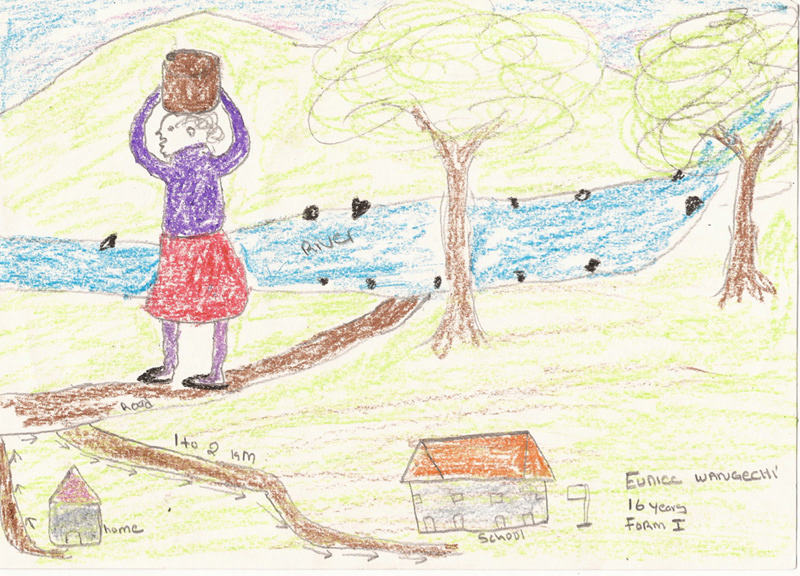Purpose of the Study:
Although the impact of water collection on the lives of women in sub-Saharan Africa is well documented, the academic community lacks studies that examine how proximate access to water affects girls’ academic enrollment and retention. Specifically, there have been only limited studies done on the correlation between water collection and female attrition rates at the secondary school level – the apex of fallout for female students in sub-Saharan Africa. Hence, the purpose of this study was two-fold: (1) to evaluate the extent to which the formal education of girls is affected by the availability of potable water (2) to assess how water collection impacts girls’ educational progression.
Given the lack of research linking access to water and the realization of gender equality in education, this study acts as a baseline for future investigation.
Significance to the field:
This study argues that reliable access to a safe water source will increase girls' school enrollment and completion rates. Given that women and girls are commonly the primary (non-economic) resource collectors of a family, the underlying logic of this study is that an improvement in the delivery of basic services, such as the installment of indoor plumbing or community wells in arid regions, will mitigate the high drop out rates of school-aged females.
While scores of studies have identified economic constraints and gender biases as determinants of families' schooling decisions, a very limited amount of research has linked access to water and gender disparity in education. Addressing this gap in academic literature is crucial to breaking existing cycles of poverty, underdevelopment and inequality.
The results of this study reveal the way in which a lack of adequate water infrastructure in Kenya’s rural areas hinders women and girls’ daily lives and opportunities for economic and social mobility. Thus, this research serves as a baseline for iteration and expansion, with the long-term goal of developing a greater understanding of the ways in which water development projects and the smarter provision of basic resources may be used as strategies for achieving gender equality in education and advancing human rights.
Although the impact of water collection on the lives of women in sub-Saharan Africa is well documented, the academic community lacks studies that examine how proximate access to water affects girls’ academic enrollment and retention. Specifically, there have been only limited studies done on the correlation between water collection and female attrition rates at the secondary school level – the apex of fallout for female students in sub-Saharan Africa. Hence, the purpose of this study was two-fold: (1) to evaluate the extent to which the formal education of girls is affected by the availability of potable water (2) to assess how water collection impacts girls’ educational progression.
Given the lack of research linking access to water and the realization of gender equality in education, this study acts as a baseline for future investigation.
Significance to the field:
This study argues that reliable access to a safe water source will increase girls' school enrollment and completion rates. Given that women and girls are commonly the primary (non-economic) resource collectors of a family, the underlying logic of this study is that an improvement in the delivery of basic services, such as the installment of indoor plumbing or community wells in arid regions, will mitigate the high drop out rates of school-aged females.
While scores of studies have identified economic constraints and gender biases as determinants of families' schooling decisions, a very limited amount of research has linked access to water and gender disparity in education. Addressing this gap in academic literature is crucial to breaking existing cycles of poverty, underdevelopment and inequality.
The results of this study reveal the way in which a lack of adequate water infrastructure in Kenya’s rural areas hinders women and girls’ daily lives and opportunities for economic and social mobility. Thus, this research serves as a baseline for iteration and expansion, with the long-term goal of developing a greater understanding of the ways in which water development projects and the smarter provision of basic resources may be used as strategies for achieving gender equality in education and advancing human rights.

“If I no longer had to collect water for my family, I would have more time to read, study and be able to participate more in class. Water affects all parts of my life. If I do not go to collect water, I cannot wash my body or uniform. If I do not wash, I am afraid that the boys at school will think I am ‘dirty’. So, when I do not have water, my self-esteem is low” (Student from Mwituria Secondary School- Form 3, Age 17).

“For the girl child, domestic chores are more valued than education because it means putting food on the table. Everyday, before I can begin my studies, I walk over 3 kilometers to the river to fill a 20 liter jerry can. Then I walk it home. Only then can I walk to school. School always comes after water collection” (Student from Shiloh Naibor SecondarySchool - Form 1, Age 16).


Drawings were done by the study's student participants to illustrate their primary household water source.

Drawings were done by the study's student participants to illustrate their primary household water source.

The study's findings indicated that girls spend an average of 3 hours per day collecting water.

The results of the study revealed that lack of access to water is a significant factor contributing to girls' underrepresentation in kenya's secondary schools.

In Kenya's rural areas, girls are disproportionately affected by the lack of access to water and are exposed to greater risks because of their responsibility to collect this vital resource.
